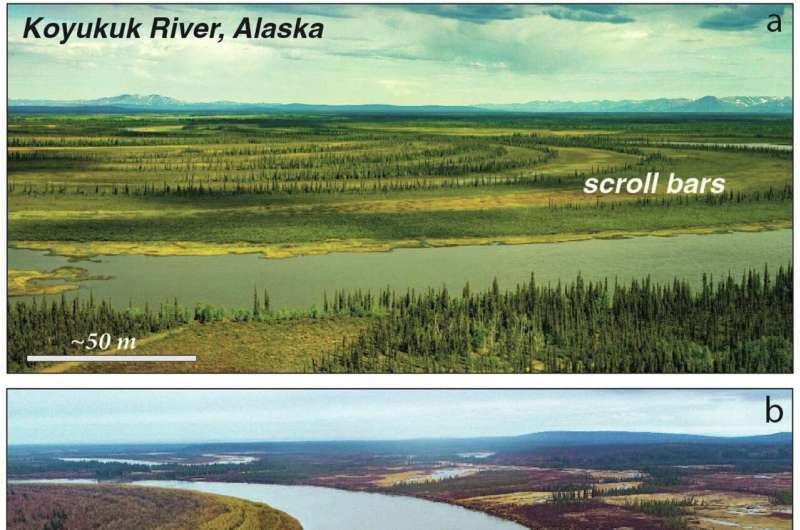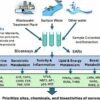Permafrost, the thick layer of perennially frozen ground that covers much of the Arctic, slows down the migration of Arctic rivers, according to a new Caltech study. River migration is a common process in which a river’s path meanders over time due to erosion of the riverbanks. This rerouting, which can also occur in sudden floods, poses a threat for many communities that live along and depend on rivers. The findings also have implications for how the Arctic region will be impacted by a warming climate as permafrost thaws over time.
The research was conducted in the Caltech laboratory of Michael Lamb, professor of geology, and is described in a paper appearing in the journal Nature.
Led by graduate student Emily Geyman, the study focused on the Koyukuk River, a large tributary of the Yukon River that winds for hundreds of miles through interior Alaska. There was debate within the scientific community about whether the frozen soil along the riverbanks serves to fortify the banks against erosion or to promote it.
“Large rivers like the Yukon or the Amazon can move tens to hundreds of feet per year,” Geyman says. “Arctic rivers in particular differ from temperate rivers because they need to thaw the material of their banks before they can pick that material up and move it.”
Due to climate change, permafrost is slowly thawing over decades. But a river can experience drastic natural changes within a single year, with flow conditions changing from very cold and fast in early spring to warm and slow a few months later. Geyman and her collaborators leveraged these major changes that take place within a single season to gain a glimpse into how the rivers will behave in response to climate change decades or centuries into the future.
In spring, the Koyukuk River swells in volume from snowmelt, flowing with fast, cold water. For more temperate rivers, a fast flow means more erosion. But in the Arctic, the temperature of the water matters—cold water is unable to thaw the frozen banks in order to migrate.

Representative field photos of the Koyukuk River near Huslia (65.689° N, 156.381° W). a, Scroll bars are arcuate traces of the river’s former position recorded in the floodplain landscape. b, The inner bend of a channel (point bar) is accretionary, whereas its outer bend (cut bank) is erosional. c, A zoom-in on an erosional permafrost cut bank. © Nature (2024). DOI: 10.1038/s41586-024-07978-w
In the new study, Geyman and her collaborators used satellite imagery of the Koyukuk over the past several years and developed a technique to decode high-resolution changes from the images. The team hypothesized that if permafrost was slowing the river’s migration, they should only see migration later in the summer when the river water has warmed up. Their hypothesis matched with the satellite data, suggesting that permafrost does, in fact, slow down river migration.
Next, the team compared sections of the river that flow through permafrost with those that do not. The Koyukuk is special because it traverses a patchwork of both permafrost and unfrozen ground. The team traveled to the Arctic to map the erosion on various bends of the river and found that sections without permafrost migrated twice as fast as analogous riverbends through permafrost terrain.
The research is part of a larger effort to understand the dynamics of rivers and how they transport carbon, nutrients, and other materials trapped in the soil.
“River migration has implications for local communities and infrastructure, and also for the Arctic environment,” Lamb says. “About 1,500 gigatons of carbon are stored in the frozen permafrost—about twice as much carbon as in the atmosphere, for comparison. There is also mercury frozen in the soil that could be liberated into rivers as permafrost thaws. We are, ultimately, trying to understand what happens to these elements in the context of river erosion.”
The work was a collaboration with local Alaska Native communities, in particular from the town of Huslia.
“It’s been an honor working with Caltech and that they selected our little community to measure permafrost thaw,” says Carl Burgett, Chief of Huslia. “With the thawing and northern geotechnical timelines, we are facing a great threat of losing at least a third of our community within a short time period. With the new data we collected, hopefully a relocation plan can be funded for our community, along with much needed infrastructure.”
More information:
Emily C. Geyman et al, Permafrost slows Arctic riverbank erosion, Nature (2024). DOI: 10.1038/s41586-024-07978-w
Provided by
California Institute of Technology
Citation:
Arctic river erosion linked to permafrost thaw (2024, October 9)



